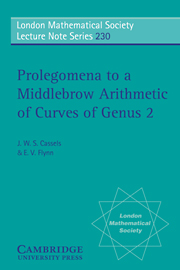Book contents
- Frontmatter
- Contents
- Foreword
- Background and conventions
- Chapter 1 Curves of genus 2
- Chapter 2 Construction of the jacobian
- Chapter 3 The Kummer surface
- Chapter 4 The dual of the Kummer
- Chapter 5 Weddle's surface
- Chapter 6 ℭ/2ℭ
- Chapter 7 The jacobian over local fields. Formal groups
- Chapter 8 Torsion
- Chapter 9 The isogeny. Theory
- Chapter 10 The isogeny. Applications
- Chapter 11 Computing the Mordell-Weil group
- Chapter 12 Heights
- Chapter 13 Rational points. Chabauty's Theorem
- Chapter 14 Reducible jacobians
- Chapter 15 The endomorphism ring
- Chapter 16 The desingularized Kummer
- Chapter 17 A neoclassical approach
- Chapter 18 Zukunftsmusik
- Appendix I MAPLE programs
- Appendix II Files available by anonymous ftp
- Bibliography
- Index rerum et personarum
Chapter 18 - Zukunftsmusik
Published online by Cambridge University Press: 10 November 2010
- Frontmatter
- Contents
- Foreword
- Background and conventions
- Chapter 1 Curves of genus 2
- Chapter 2 Construction of the jacobian
- Chapter 3 The Kummer surface
- Chapter 4 The dual of the Kummer
- Chapter 5 Weddle's surface
- Chapter 6 ℭ/2ℭ
- Chapter 7 The jacobian over local fields. Formal groups
- Chapter 8 Torsion
- Chapter 9 The isogeny. Theory
- Chapter 10 The isogeny. Applications
- Chapter 11 Computing the Mordell-Weil group
- Chapter 12 Heights
- Chapter 13 Rational points. Chabauty's Theorem
- Chapter 14 Reducible jacobians
- Chapter 15 The endomorphism ring
- Chapter 16 The desingularized Kummer
- Chapter 17 A neoclassical approach
- Chapter 18 Zukunftsmusik
- Appendix I MAPLE programs
- Appendix II Files available by anonymous ftp
- Bibliography
- Index rerum et personarum
Summary
Introduction. This chapter discusses outstanding problems and possible future developments, some of which we have already alluded to.
Framework. A more appropriate theoretical framework than the jacobian might be the quotient Pic/D of the Picard group by the canonical divisor. This has a natural ℤ/2ℤ grading. Its quotient by the ±Y involution unifies the Kummer and its dual, as Chapters 3 and 6 suggest that they should be unified. The operators ϒ(α) of Chapter 17, Section 1 suggest that there is an underlying noncommutative structure.
Principal homogeneous spaces. In the genus 1 theory, curves of genus 1 are principal homogeneous spaces over the elliptic curves (= abelian varieties of dimension 1). They are naturally the ‘twists’ of the elliptic curves by cocycles. The principal homogeneous spaces of order 2 give a way to study ℭ/2ℭ without leaving the ground field. For genus 2, the desingularized Kummer of Chapter 16 gives an opportunity to construct the principal homogeneous spaces of order 2, which are now surfaces, in a way closely analogous to the genus 1 construction. They might be equally useful for the study of ℭ/2ℭ.
Duality. In both the geometric and the highbrow arithmetic theory of curves, the abelian variety duality of the jacobian has a central rôle. As we have several times observed, this duality does not carry over in a naïve way to our setup. We suspect that further study of the desingularized Kummer S of Chapter 16 will give an appropriate generalization of the Poincaré divisor.
- Type
- Chapter
- Information
- Prolegomena to a Middlebrow Arithmetic of Curves of Genus 2 , pp. 186 - 189Publisher: Cambridge University PressPrint publication year: 1996

